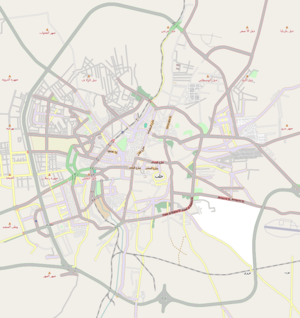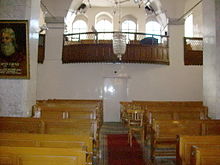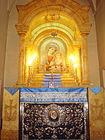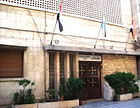- Cathedral of the Forty Martyrs (Aleppo)
-
For other uses, see Holy Forty Martyrs Church.
Saint Forty Martyrs Cathedral
Սրբոց Քառասնից Մանկանց Մայր Եկեղեցի
The belfry of the Forty Martyrs Cathedral
Basic information Location Jdeydeh Area, Salibeh Street,
 Aleppo, Syria
Aleppo, SyriaGeographic coordinates 36°12′22″N 37°09′19″E / 36.2062°N 37.1552°ECoordinates: 36°12′22″N 37°09′19″E / 36.2062°N 37.1552°E Affiliation Armenian Apostolic Church Region Aleppo Year consecrated 15th century Ecclesiastical or organizational status active Architectural description Architectural type Church Architectural style basilica with no dome The Forty Martyrs Armenian Cathedral of Aleppo, Syria is a 15th century Armenian Apostolic church located in the old Christian district of Aleppo, at Salibeh street of Jdeydeh quarter. It is significant among Armenian churches for having three altars. The church has no dome, but the bell tower is considered to be one of the unique samples of the baroque architecture in Aleppo. It is significant for being one of the oldest functioning churches in the Armenian diaspora.
Contents
Armenians in Aleppo
Main article: Armenians in SyriaThe first significant Armenian presence in the city of Aleppo dates to the 1st century BC, when Armenia under Tigranes the Great subjugated Syria, and chose Antioch as one of the four capitals of the short lived Armenian Empire. After 301 AD, when Christianity became the official state religion of Armenia and its population, Aleppo became an important center for Armenian pilgrims on their way to Jerusalem. Yet, the Armenians did not form into an organized community in Aleppo until the Armenian presence grew noticeably during the 11th century at the times of the Armenian Kingdom of Cilicia, when a considerable number of Armenian families and merchants settled in the city creating their own businesses and residences. With the foundation of Armenian schools, churches and later on the prelacy, Armenians presented themselves as a well-organized community during the 14th century.
The Armenian population of Aleppo continued to grow as Aleppo was swallowed into the Ottoman Empire. The Ottoman Empire had a large indigenous Armenian population in its Eastern Anatolia region, from where some Armenians moved to Aleppo in search of economic opportunity. The Armenian presence in Aleppo grew exponentially after 1915, when it became an immediate haven for refugees of survivors of the Armenian Genocide. Tens of thousands of Armenian refugees, likely well over 100,000, settled in Aleppo during this period. By some estimates, Armenians accounted for a quarter of Aleppo's population by the middle of the twentieth century, by which time they had become a respected, upwardly mobile community. Later, as a result of political upheaval in Syria, Armenians began to emigrate to Lebanon and later to Europe, the Americas and Australia, especially in the 1970s and 1980s. Nonetheless, Aleppo remains a center of the worldwide Armenian diaspora, ranging between 50,000 and 70,000 Armenians residents.
Church history
The Armenian church of the Forty Martyrs in Aleppo was mentioned for the first time in 1476, in the second edition of the book The Exploit of the Holy Bible, written by Father Melikseth in Aleppo.
It was erected to replace a small chapel in the old Christian cemetery. The church was named in the honour of a group of Roman soldiers who faced martyrdom near the city of Sebastia in Lesser Armenia, and were all venerated in Christianity as the Forty Martyrs of Sebaste. Until the end of the 15th century the church was of very small size with a capacity of only 100 believers. In 1499, large-scale renovation works were applied and within two years, the church was enlarged and a new prelacy building (Armenian Prelacy of Beria or Beroea) was erected in the church yard, funded by the donation of an Armenian elite named Reyis Baron Yesayi.[1] In the following years, the church frequently became a temporary seat of various Armenian catholicoi of the Holy See of Cilicia.
During the first years of its consecration, the church was surrounded with tombsstones of the Armenian cemetery, until 1579 when the cemetery was moved and only clergymen and the elites of the community were allowed to be buried in the church yard.
The church was renovated again in 1616 by the donation of the community leader-emir Khoja Bedig Chelebi and the supervision of his brother Khoja Sanos Chelebi. At the end of the year the church was reopened with the presence of Catholicos Hovhannes IV of Aintab (Hovhannes 4th Aintabtsi) and Bishop Kachatur Karkaretsi.[2]
In 1624, as a result of the growing number of Armenian residents and pilgrims, the Armenian prelacy started to build a quarter near the church, which is still keeping its original name Hokedun (Spiritual House). It was designated to serve as a settlement for the Armenian pilgrims on their way to Jerusalem. The Hokedun was built by the donation of Khoja Gharibjan.
Nowadays, the church has 3 altars, an upper story built in 1874 and a baptismal font placed in 1888.
The church never had a belfry until 1912 when a belfry tower was erected by the donation of Syrian-Armenian philanthropist Rizkallah Tahhan from Brazil. During the second half of the 20th century, the interior of the church underwent massive renovations to match the requirements of Armenian churches. On 28 May 1991, by the donation of Keledjian brothers from Aleppo, a khachkar-memorial was placed in the yard near the church entry dedicated to the victims of the Armenian Genocide.
On 26 April 2000, the Armenian community of Aleppo marked the 500th anniversary of the first enlargement of the church under the patronage of His Holiness Aram I Catholicos, during the period of Archbishop Souren Kataroyan.
Icons
The church is rich for both ancient and modern-day icons, with more than 30 samples:
- The Mother of God (canvas, 96x118, 1663 by Der-Megerdich)
- Virgin Mary with Jesus (canvas, 115x145cm, 1669 by an unknnown Armenian painter)
- The Baptism of Jesus (canvas, 66x90cm, from the 17th century)
- The Worship of the Magi (canvas, 112x134cm, from the 17th century by an unknnown Armenian painter)
- Saint John The Baptist (wood paint, 39x76cm , 1720 by Kevork Anania)
- Saint Joseph (wood paint, 39x76cm, 1720 by Kevork Anania)
- Virgin Mary with Jesus (wood paint, 46x126cm, 1729 by Kevork Anania)
- The Baptism of Jesus Christ (wood paint, 86x105cm, 1756 by Kevork Anania)
- Virgin Mary surrounded by The Apostles (canvas, 70X80cm, from the late 18th century by an unknnown Armenian painter)
- The Last Judgment, one of the most famous icons of the Aleppine school (canvas, 400x600cm, 1703 by Nehmatallah Hovsep)
With the initiative of Archbishop Souren Kataroyan, the majority of the icons were renovated between 1993 and 1996 by the Armenian expert Andranik Antonyan.
Church of the Holy Mother of God
The old church of the Holy Mother of God was built before 1429, at a time when the Armenian community was formed as a significant community in Aleppo with its own clergymen, scholars and the prelacy. This small church has witnessed several renovations, in 1535, 1784, 1849 and 1955 respectively. The church remained active until the beginnings of the 20th century, when it was turned into a library. In 1991, the building was turned into the Zarehian Treasury of the Armenian Apostolic Church of Aleppo, in the memory of Catholicos Zareh I of the Great House of Cilicia, who had served as archbishop of the diocese of Aleppo before becoming catholicos.
Current status
The Forty Martyrs Cathedral is the seat of the Armenian prelacy of Aleppo and one of the oldest acting churches in the city. It is also one of the oldest functioning churches in the Armenian diaspora. In 1991, the old church of the Holy Mother of God was reopened as Zarehian Treasury; the museum of the Armenian Apostolic Church within the Forty Martyrs Carhedral complex. The old building of the prelacy which is located between the museum and the current church, is under renovation. The church complex also contains the Haygazian Armenian School, the Avetis Aharonian theatre and the Nikol Aghbalian branch of Hamazkayin Educational and Cultural Society. The current building of the prelacy stands next to the church, just few meters away.
Gallery
- Forty Martyrs Cathedral of Aleppo
-
The Armenian Genocide monument in the church yard
See also
- Armenian Apostolic Church
- Echmiadzin
- List of Armenian Catholicoi of Cilicia
- Church of the Holy Mother of God (Aleppo)
- Holy See of Cilicia
References
- ^ A manuscript found in April 2000, kept in Zarehian Museum-Treasury of the Forty Martyrs Cathedral
- ^ Mentioned in an edition of the Holy Bible written in Aleppo by historian Simeon Lehatsi (Simeon of Poland), now exhibited in the British Library of London among the collection of Armenian manuscripts
External links
 Contemporary Armenian Churches and Seminaries
Contemporary Armenian Churches and Seminaries 
Armenia Etchmiadzin Cathedral · Gevorkian Theological Seminary · Gayane · Geghard · Goshavank · Hovhannavank · Hripsime · Karmravor · Kecharis · Khor Virap · Oshakan · Saghmosavank · Sanahin · Shoghakat · Tegher · Vaskenian Theological Academy · Yeghvart Yerevan: Holy Trinity · Katoghike · Saint Poghos-Petros Church · Saint Gregory the Illuminator Cathedral · Saint John the Baptist · Saint Sargis (Kentron) · Saint Sarkis (Nor Nork) · Surb Zoravor Astvatsatsin Church 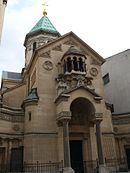
Nagorno Karabakh Republic (Artsakh) France Île-de-France: St. Jean-Baptiste Armenian Apostolic Cathedral, Paris · St. Gregory the Illuminator Church, Chaville · Holy Mother of God Armenian Apostolic Church, Issy-les-Moulineaux · St. Paul and St. Peter Church, Alfortville · Holy Cross of Varak Armenian Church, Arnouville-Lès-Gonesse · Holy Cross Armenian Catholic Cathedral, Paris · St. Gregory the Illuminator Armenian Catholic Church, Arnouville-Lès-Gonesse · Rhône-Alpes: St. Jack Armenian Apostolic Cathedral, Lyon · Holy Mother of God Armenian Apostolic Church, Décines · St. Gregory the Illuminator Church, St. Etienne · Saint Neshan Church, Charvieu-Chavagneux · Saint Sahak Church, Valence · St. Gregory the Illuminator Church, Valence · Armenian Apostolic Church, Grenoble · St. Nicolas Church, Romans · Armenian Apostolic Church, Vienne · Armenian Catholic Church, Lyon · Armenian Catholic Church, Valence · St. Nerses Armenian Catholic Church, Saint Chamond · Marseille and Southern France: St. Mesrob and St. Sahak Armenian Apostolic Cathedral, Marseille · Holy Mother of God Armenian Apostolic Church, Marseille · St. Garabed Church, Marseille · St. Thaddeus and St. Bartholomew Chruch, Marseille · St. Jack Church, Marseille · Holy Savior Armenian Apostolic Church, La Ciotat · Holy Mother of God Armenian Apostolic Church, Nice · St. John Armenian Church, Saint-Raphaë · St. Vartan Armenian Church, Avignon · St. Gregory the Illuminator Armenian Catholic Church, Marseille Turkey Aghtamar · Holy Apostles Church of Kars · Holy Apostles Monastery · Horomos · Ktuts · Monastery of the All-Saviour (Trebizond) · Mren · Narekavank · Saint Bartholomew Monastery · Saint Karapet Monastery · St. Marineh Church, Mush · Tekor Basilica · Varagavank Georgia Tbilisi: Cathedral of Saint Gevorg · Church of the Holy Seal · Church of the Red Gospel · Ejmiatsin · Holy Mother of God (Bethlehem) · Holy Mother of God (Mens) · Holy Mother of God (Norashen) · Saint George · Saint Gevorg of Mughni · Saint Karapet · Saint Minas · Saint Stephanos · Chugureti St. Astvatsatsin Lebanon Armenian Catholicosate of Cilicia · Armenian Catholic Patriarchate ·
Beirut: Armenian Church of the Holy Cross, Beirut · Holy Cross (St. Neshan) Church, Beirut Central District · St. Elie - St. Krikor Lousavoritch Cathedral, Beirut · Saint George Armenian Apostolic Church, Beirut · Saint Hagop Church, Beirut · Saint Sarkis Church, Beirut · Armenian Catholic Church of the Annunciation, Beirut · Armenian Catholic Church of the Annunciation , Beirut ·
Bourj Hammoud: The Church of the Forty Martyrs of Sebastia, Bourj Hammoud · St. Mesrob Church, Bourj Hammoud · Holy Mother of God Armenian Church, Bourj Hammoud · St. Saviour Armenian Catholic Church, Bourj Hammoud · St. Savior Armenian Catholic Church, Bourj Hammoud
Bikfaya: Armenian Apostolic Seminary at Bikfaya · Convent Of Mekhitarist Fathers, Bikfaya ·
Anjar: St. Paul Church, Anjar · Our Lady of the Rosary Armenian Catholic Church, Anjar ·
Others: Our Lady Convent Of Bzoummar · Holy Cross Church, Zalka · St. Rita Church, Mezher · Holy Pentecost Armenian Apostolic Church, Tripoli · Our Lady of Fatima Armenian Catholic Church, Zahle ·Syria Aleppo: Church of the Holy Mother of God · Cathedral of the forty martyrs of Sebastia · St. Hagop Church · St. Gregory the Illuminator Church · Holy Trinity Church · Holy Cross Church · Church of Our Lady of Annunciation · Cathedral of Our Mother of Reliefs · Damascus: St. Sarkis Armenian Church, Damascus · Our Lady of the Universe Armenian Catholic Church, Damascus · Latakia: St. Hripsime Church, Yacoubieh · St. Anna Church, Yacoubieh · Church of the Holy Mother of God, Kesab · Church of the Holy Mother of God, Latakia · Church of the Holy Mother of God, Karadouran · Armenian Church, Ekizoluk · St. Stephen Church,Aramo · St. George Church, Ghnemiyeh · Our Lady of the Assumption, Kesab · Deir ez-Zor: Armenian Genocide Memorial Church (Der Zor) · Ar-Raqqah: Church of the Holy Mother of God, Ar-Raqqah · Holy Cross Church, Abyad · Al-Hasakah: Church of the Holy Mother of God, Al-Malikiyah · Holy Cross Mother of God Church, Ra's al-'Ayn · Saint John the Baptist Church, Al-Hasakah · Saint Joseph Armenian Catholic Church, Al-Qamishli · Holy Family Church, Al-Hasakah Azerbaijan Iran Saint Sargis · Saint Thaddeus · Vank Cathedral Israel Cathedral of St. James · Church of the Archangels · St. Toros Church · Chapel of Saint Helena · Saint Nicholas Monastery United States Mother Cathedral of the Western Diocese, Burbank · Saint Mary's Armenian Church, Glendale · Saint Gregory the Illuminator Catholic Church, Glendale · St. Vartan Cathedral · Saint Sarkis of Dearborn Other countries Categories:- Armenian churches in Syria
- Churches in Aleppo
- Religious organizations established in the 15th century
Wikimedia Foundation. 2010.

